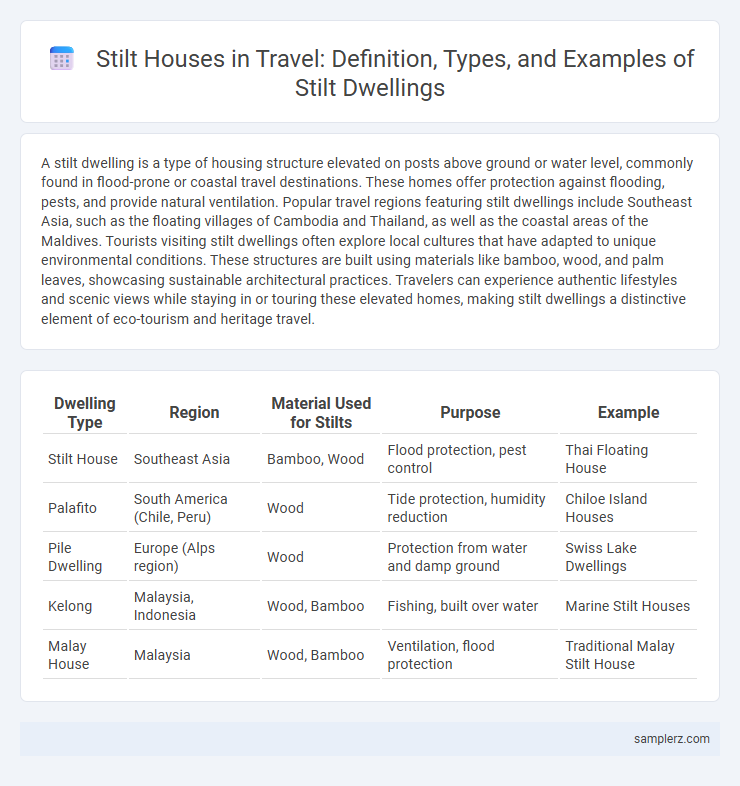A stilt dwelling is a type of housing structure elevated on posts above ground or water level, commonly found in flood-prone or coastal travel destinations. These homes offer protection against flooding, pests, and provide natural ventilation. Popular travel regions featuring stilt dwellings include Southeast Asia, such as the floating villages of Cambodia and Thailand, as well as the coastal areas of the Maldives. Tourists visiting stilt dwellings often explore local cultures that have adapted to unique environmental conditions. These structures are built using materials like bamboo, wood, and palm leaves, showcasing sustainable architectural practices. Travelers can experience authentic lifestyles and scenic views while staying in or touring these elevated homes, making stilt dwellings a distinctive element of eco-tourism and heritage travel.
Table of Comparison
| Dwelling Type | Region | Material Used for Stilts | Purpose | Example |
|---|---|---|---|---|
| Stilt House | Southeast Asia | Bamboo, Wood | Flood protection, pest control | Thai Floating House |
| Palafito | South America (Chile, Peru) | Wood | Tide protection, humidity reduction | Chiloe Island Houses |
| Pile Dwelling | Europe (Alps region) | Wood | Protection from water and damp ground | Swiss Lake Dwellings |
| Kelong | Malaysia, Indonesia | Wood, Bamboo | Fishing, built over water | Marine Stilt Houses |
| Malay House | Malaysia | Wood, Bamboo | Ventilation, flood protection | Traditional Malay Stilt House |
Traditional Stilt Houses Around the World
Traditional stilt houses, such as the Malay Rumah Panggung in Southeast Asia and the Ganvie lake dwellings in Benin, exemplify effective adaptation to flood-prone environments. These elevated structures provide ventilation, protect against wild animals, and minimize water damage during seasonal flooding. In the Amazon Basin, indigenous communities also construct stilt homes to thrive in swampy landscapes, showcasing diverse cultural engineering techniques.
Unique Features of Stilted Dwellings
Stilted dwellings, common in flood-prone regions like Southeast Asia and the Amazon, showcase elevated platforms supported by wooden or bamboo poles, protecting inhabitants from rising waters and pests. These structures facilitate natural ventilation and adapt seamlessly to uneven terrain, promoting resilience against environmental challenges. The unique integration of stilts enhances safety while preserving traditional architectural aesthetics, making them iconic in sustainable travel destinations.
Stilt Architecture in Southeast Asia
Stilt architecture is prominent in Southeast Asia, with traditional dwellings in countries like Thailand, Indonesia, and Malaysia often elevated on wooden stilts to protect against flooding and pests. These structures provide natural cooling by promoting airflow beneath the house, essential in the region's tropical climate. The architectural style reflects adaptive living in flood-prone areas and showcases the cultural heritage of ethnic groups such as the Dayak and the Toraja.
Coastal Stilt Homes: Adapting to Water
Coastal stilt homes exemplify architectural adaptation to water-prone environments by elevating living spaces above tides and floods, ensuring safety and durability. These structures use tall wooden or concrete stilts to provide ventilation, reduce moisture damage, and protect against sea-level rise. Found in regions like Southeast Asia and the Caribbean, coastal stilt homes blend traditional design with practical solutions for climate resilience.
Indigenous Stilt Houses in South America
Indigenous stilt houses in South America, such as the palafitos found in the Amazon Basin and the Andean region, are designed to protect inhabitants from seasonal flooding and wildlife. These elevated dwellings use wooden stilts to raise the living spaces above water levels, ensuring ventilation and reducing humidity. The architecture reflects adaptation to diverse ecosystems, incorporating locally sourced materials like bamboo and palm thatch for sustainability and resilience.
Modern Innovations in Stilt House Design
Modern innovations in stilt house design enhance stability and environmental harmony by integrating advanced materials like reinforced steel and weather-resistant composites. Elevated structures now incorporate sustainable energy solutions such as solar panels and rainwater harvesting systems, improving off-grid capabilities. Smart home technology, including automated climate control and remote monitoring, further elevates comfort and security for travelers seeking unique stilt house accommodations.
Environmental Benefits of Stilt Construction
Stilt construction in dwellings elevates homes above flood-prone or waterlogged areas, significantly reducing the risk of water damage and soil erosion. This architectural technique promotes natural water drainage and preserves the local ecosystem by minimizing ground contact and disturbance. Elevated structures also enhance air circulation beneath the home, contributing to cooler indoor temperatures and reduced reliance on artificial cooling systems, thereby lowering energy consumption.
Famous Travel Destinations with Stilt Villages
Famous travel destinations with stilt villages include the iconic Kampong Ayer in Brunei, known as the "Venice of the East," featuring houses built over the Brunei River on wooden stilts. In Southeast Asia, the floating stilt villages of Tonle Sap Lake in Cambodia offer unique glimpses into traditional fishing communities with homes elevated above water. The indigenous Guna Yala islands in Panama showcase vibrant stilted dwellings designed to protect against rising tides and provide spectacular ocean views.
Stilt Houses: Safety and Flood Protection
Stilt houses in regions prone to flooding, such as Southeast Asia and the Maldives, elevate living spaces above water levels to prevent damage during monsoons and tides. This architectural design enhances safety by minimizing risks of water intrusion and structural weakening, while also supporting natural water flow and reducing environmental impact. Elevated dwellings improve air circulation and help residents avoid pests and damp conditions commonly associated with flood-prone areas.
Experiencing Local Culture in Stilt Communities
Stilt houses in regions like Southeast Asia and the Amazon Basin provide travelers with immersive experiences of local culture, showcasing traditional architectural techniques adapted to flood-prone environments. Staying in these elevated dwellings allows visitors to engage with indigenous communities, participate in daily rituals, and appreciate sustainable living practices deeply connected to nature. This authentic cultural exchange fosters a profound understanding of the residents' heritage and environmental harmony.

example of stilt in dwelling Infographic
 samplerz.com
samplerz.com